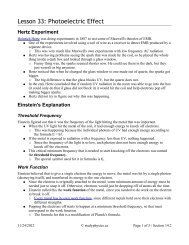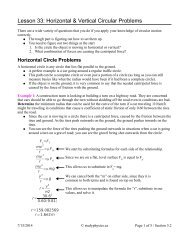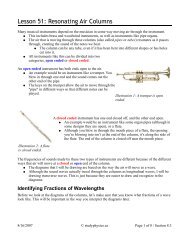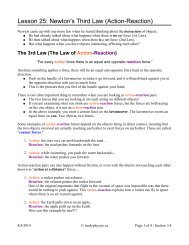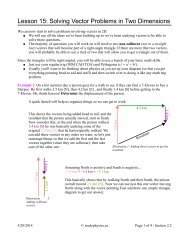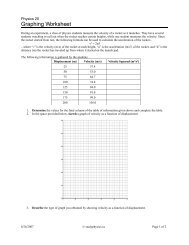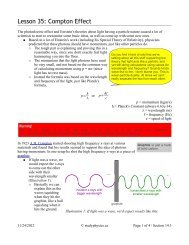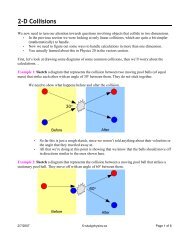Lesson 5: Elastic and Inelastic Collisions
Lesson 5: Elastic and Inelastic Collisions
Lesson 5: Elastic and Inelastic Collisions
- No tags were found...
Create successful ePaper yourself
Turn your PDF publications into a flip-book with our unique Google optimized e-Paper software.
Let's figure out a question <strong>and</strong> then see if it is elastic or inelastic collision.Example 1: One way to test the speed of a bullet shot from a gun is to use a device called a ballisticpendulum. Because it is based on well understood physics, it can give very accurate results even thoughthe equipment is quite simple. A block of material such as wood is hung from supporting wires asshown below. When the bullet is shot at the pendulum, it hits <strong>and</strong> becomes embedded in the pendulum.Together, the pendulum <strong>and</strong> the bullet swing upwards. By measuring the maximum height that thependulum <strong>and</strong> bullet swing to, the speed of the bullet just before impact can be calculated. For thisproblem, a 0.0200 kg bullet collides with a 5.7500 kg pendulum. After the collision, the pair swings upto a maximum height of 0.386 m . Determine the velocity of the bullet just before impact.velocity = ?bulletblockMaximum HeightIllustration 1: A Ballistic PendulumPart 1: Conservation of EnergyWe can't use conservation of energy to examine what happened before <strong>and</strong> after the collision.We can only do that with conservation of momentum. For now, let's just look at what happenedafter the bullet hit the block, making it swing upwards.We know that the kinetic energy of pendulum-bullet just after the collision is turned intogravitational potential energy as it swings upwards, so...E k = E p½ mv 2 = mgh½ v 2 = ghv= 2ghv=29.810.386v=2.75m/sThis is the velocity of the pendulum-bullet just after the collision has happened.Part 2: Conservation of MomentumNow we have enough information to use conservation of momentum to examine before <strong>and</strong>after the collision, which will allow us to calculate the velocity of the bullet just before it hit thependulum. This is what conservation of momentum is good at... looking at both the before <strong>and</strong>after parts of a collision.9/5/2012 © studyphysics.ca Page 2 of 3 / Section 9.3
p total = p total 'm p v p + m b v b = m p v p ' + m b v b '0 + m b v b = v'(m p + m b )0.0200 v b = 2.75 (5.7500 + 0.0200)0.0200 v b = 2.75 (5.7700)0.0200 v b = 15.9v b = 794 m/sThe bullet was traveling at 794 m/s just before it hit the pendulum.Example 2: In Example 1 we can assume that the collision was inelastic (since we know it'smacroscopic). But let's be careful <strong>and</strong> check it out mathematically... that's the only way to be certain.Using the information from Example 1, determine if the collision was elastic or inelastic.Initially, only the bullet was moving. We only need to calculate its kinetic energy <strong>and</strong> use thatvalue as the total initial kinetic energy.E k= 1 2 mv2 = 1 2 0.02007942 =6304.36 J =6.30e3 JJust after the collision, the bullet <strong>and</strong> the block move together as one mass at the same velocity.We'll only need to do one calculation for the total final kinetic energy.E k= 1 2 mv2 = 1 2 5.77002.752 =21.8178125 J =21.8 JIt's obvious that after the collision there is considerably less kinetic energy than at the start. Thisis an inelastic collision. In fact, only about 0.346% of the kinetic energy remained after thecollision. To get the percentage, just divide the final by the initial.Homeworkp482 #1, 2p484 #29/5/2012 © studyphysics.ca Page 3 of 3 / Section 9.3



